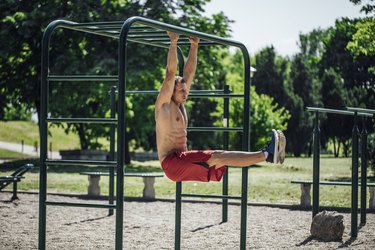
Core strength is to daily movement what proper communication is to a healthy relationship: essential.
Composed of far more than just the six-pack muscle (the rectus abdominis), the core consists of your internal and external obliques, pelvic floor muscles, traverse abdominis, multifidus and erector spinae. These muscles, according to Mia Nikolajev, CSCS, work together to protect your organs, keep you standing up straight and control your ability to twist, turn, bend and hinge.
Video of the Day
Video of the Day
If your core isn't strong, your other muscles — especially the muscles in your lower back and hips — compensate for the weakness, which can lead to injury in the long term, she says. "Because your core impacts your balance and stability, having a weak core also ramps up the likelihood that you'll fall." In summary: strengthening your midsection is very beneficial.
But what ab exercises actually deserve your time, sweat and yes, sometimes tears? According to Nikolajev and Laura Miranda, DPT, CSCS, creator of PURSUIT, a training program dedicated to turning your city into your gym, likely the ones you've been avoiding. Below, they share seven ab exercises that are most effective, and in their experience, also the most dreaded.
1. High Plank
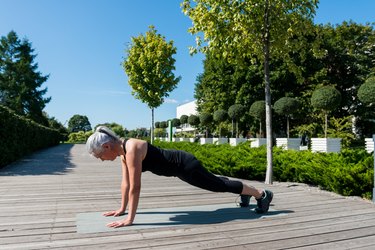
High planks seem simple — after all, they just require you to hang out at the top of a push-up, right? But that's in part why people dislike them, according to Nikolajev. "People tend to get discouraged because, if you're doing it right, it's far harder than meets the eye."
She explains: A good plank requires you to engage your midsection, squeeze your glutes and lats and press into the floor with your palms and fingers. Sure, it's a lot to remember, but their degree of difficulty isn't a good reason to snub them altogether.
"Planks work all the muscles in your core, as well as your glutes, quads, shoulders, triceps and more," she says. In other words, they're a true full-body movement.
She recommends holding the plank for 10 to 15 seconds to start, working up to a minute as your endurance improves. Can't hold the position with good form for 10 seconds? Rather than positioning your hands on the floor, position them on an elevated box or step.
2. Hollow Body Rock
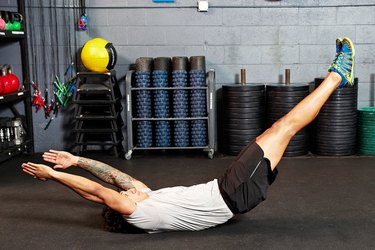
At first glance, hollow body variations may look easy-peasy. But in reality, they're another deceptively hard-core burner (pun definitely intended).
To try the hollow body rock, lie on your back with your arms extended overhead, legs extended out straight. Squeeze your core and press your lower back into the ground while lifting your arms and legs. Now you're in the hollow body position. Activate throughout your midsection to rock your shoulders to tailbone with control. You'll know you're doing it right when your body resembles the base of a rocking chair.
Important: The rocking motion is incredibly subtle. If your rocks are aggressive, likely you're using momentum — not muscle — to move.
"The ability to keep your core engaged while you move will give you the prerequisite strength and skill you need to perform almost any other movement," Nikolajev says. That includes pull-ups, toes-to-bar, push-ups, clean and jerks and front squats (just to name a few).
3. Hanging L-Sit
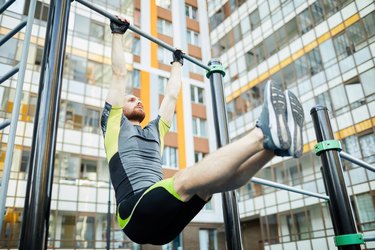
Even if you follow just one "fitfluencer" on social media, you've seen the hanging L-sit. After all, the move is as impressive-looking as it is effective.
Unfamiliar with the hanging L-sit? To do one, grab onto a pull-up bar. Engage your lats by pulling your pinkies down into the bar and rotating them outward. Keeping your legs tight and straight, use your lower abs to raise your legs parallel to the floor (or as high as you can get them). Then, keep on hanging out without losing tension in your body.
"Moving your legs from the hanging position forces your body to call on your lower abdominal muscles, which don't often get worked," Nikolajev says.
Tip
While ideally, you’d raise your legs until they’re parallel to the ground, doing so requires not only strong lower abs, but a decent amount of hip mobility as well. So, to get the most out of this exercise, warm up your hips ahead of time with stretches like runner’s lunge and figure four.
4. Bird Dog
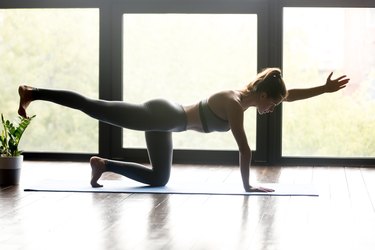
Bird dog may sound like a cyborg monster or local pet shop name, but it's actually a core exercise — and a rather good one at that. Also known as the quadruped, the bird dog involves extending your opposite arm and leg from an all-fours position.
According to Miranda, doing a few sets of 10 or 12 reps per side of this exercise three or four times a week will help improve your balance, coordination and stability — but only if you're doing it correctly.
"The goal of the exercise is to extend your limbs without tilting your hips," Miranda says. "Problem is, people often lose their core stability, which causes their body to twist all over the place." And that twisting isn't doing your lower back or hips any favors.
Before you begin moving your arms and legs, set your back to a neutral position — meaning not a Cat or Cow pose position. When your back is flat, think about kissing your bellybutton to your spine to engage your core. Then (and only then!) should you extend your limbs. Also, don't raise your limbs to shoulder and glute height if you can't do so without wobbling.
5. Barbell Deadlift
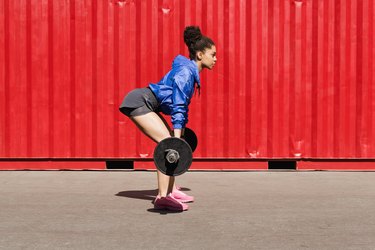
No doubt, deadlifts are an incredible lower-body exercise. But they didn't earn their former nickname 'healthlift' by working just your legs. In addition to your hamstrings, quads, calves and glutes, Nikolajev says this move also strengthens your core, upper back, triceps and neck muscles.
To deadlift with a barbell, stand with your feet shoulder-width apart, bar over your laces. Hinge at your hips, then, keeping your arms straight, grab the bar. Brace your core, then pull the bar along the front of your body as you stand, squeezing your glutes at the top.
While it's true that the deadlift is as high-skill as it sounds, you shouldn't avoid it. Because when done correctly, it's both safe and effective.
Nikolajev's tip: If you're back in the gym, ask a trainer to take a peek at your form. If not, film yourself from the side, then compare your video to an instructional video on YouTube. Or better yet: Send it to an online trainer for feedback. (Many trainers will be happy to provide feedback in exchange for a few bucks.)
6. Squat
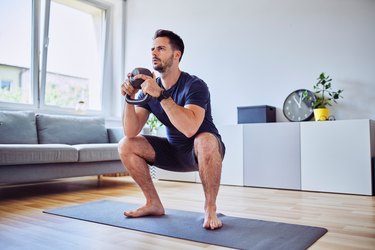
Miranda has a PSA: "The squat is an ab exercise." That's right, the move lauded for its peach-pumping perks also comes in clutch when you want to strengthen your core — especially when it's weighted.
Miranda explains: In order to sit your butt back and hinge at your hips and not round forward, your core has to be engaged. If your core goes loosey-goosey, it puts your lower back into a compromised position.
If you've never dropped it low before, she recommends starting with the basic air squat. Once you can crank out 20 with no problem, grab a kettlebell or dumbbell and give goblet squats a whirl, she says. "Your core will have to engage even more when there's a weight pulling your body forward."
7. Pallof Press
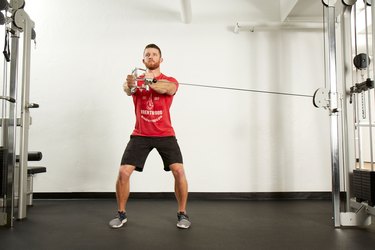
While often overlooked, both the Pallof isometric hold and the Pallof press target the lower and upper core muscles at the same time.
For these multi-taskers, you'll need a resistance band and some kind of anchor point (like a squat rig, column or tree). Loop the band around the anchor at chest height, then stand parallel to the anchor point. Clasp your hands around the loose end and pull it taught. "To keep the band from yanking you out of position you'll have to fire up your entire midsection," says Miranda.
She recommends beginners stick to the static variation of the movement. "Hold for 20 seconds on each side before increasing the time."
Once you've worked up to a minute per side, you can progress from to the Pallof press. Once in the position described above, slowly pull the band in toward your chest and press it straight ahead. "The goal is to lock your core in so well that there is no motion in your body besides your arms," she says.